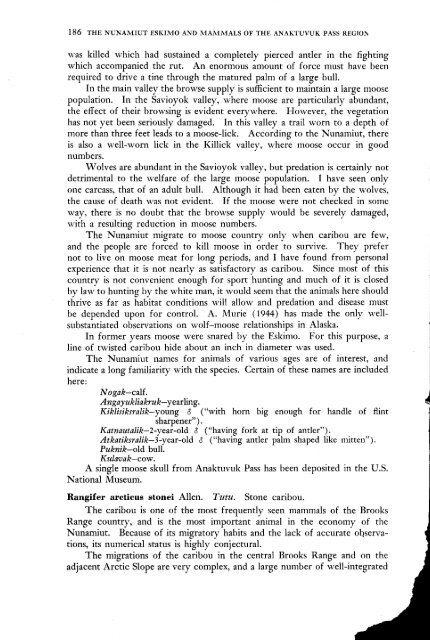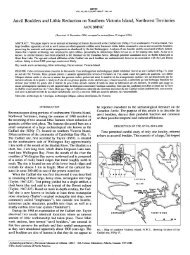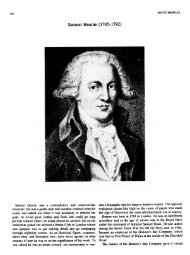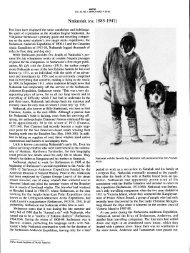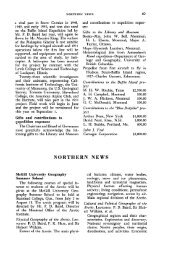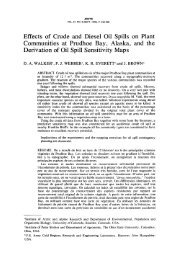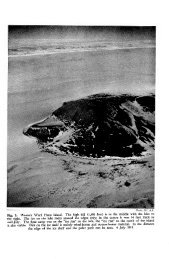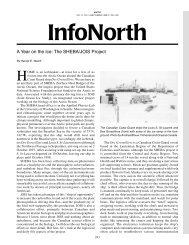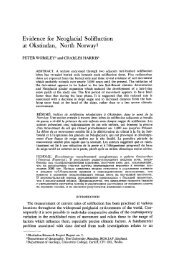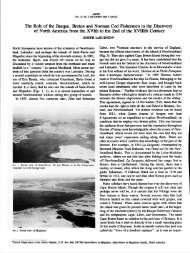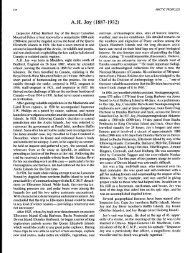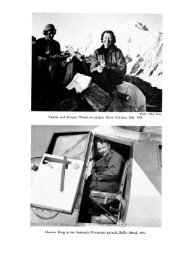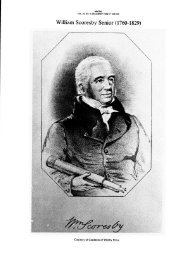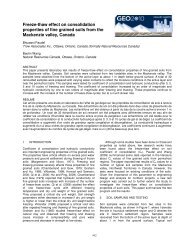NOTES ON THE NUNAMIUT ESKIMO AND MAMMALS OF ... - arctic
NOTES ON THE NUNAMIUT ESKIMO AND MAMMALS OF ... - arctic
NOTES ON THE NUNAMIUT ESKIMO AND MAMMALS OF ... - arctic
You also want an ePaper? Increase the reach of your titles
YUMPU automatically turns print PDFs into web optimized ePapers that Google loves.
186 <strong>THE</strong> <strong>NUNAMIUT</strong> <strong>ESKIMO</strong> <strong>AND</strong> <strong>MAMMALS</strong> <strong>OF</strong> <strong>THE</strong> ANAKI‘UVUK PASS REGlOh<br />
was killed which had sustained a completely pierced antler in the fighting<br />
which accompanied the rut. An enormous amount of force must have been<br />
required to drive a tine through the matured palm of a large bull.<br />
In the main valley the browse supply is sufficient to maintain a large moose<br />
population. In the Savioyok valley, where moose are particularly abundant,<br />
the effect of their browsing is evident everywhere. However, the vegetation<br />
has not yet been seriously damaged. In this valley a trail worn to a depth of<br />
more than three feet leads to a moose-lick. According to the Nunamiut, there<br />
is also a well-worn lick in the<br />
numbers.<br />
Killick valley, where moose occur in good<br />
Wolves are abundant in the Savioyok valley, but predation is certainly not<br />
detrimental to the welfare of the large moose population. I have seen only<br />
one carcass, that of an adult bull. Although it had been eaten by the wolves,<br />
the cause of death was not evident. If the moose were not checked in some<br />
way, there is no doubt that the browse supply would be severely damaged,<br />
with a resulting reduction in moose numbers.<br />
The Nunamiut migrate to moose country only when caribou are few,<br />
and the people are forced to kill moose in order to survive. They prefer<br />
not to live on moose meat for long periods, and I have found from personal<br />
experience that it is not nearly as satisfactory as caribou. Since most of this<br />
country is not convenient enough for sport hunting and much of it is closed<br />
by law to hunting by the white man, it would seem that the animals here should<br />
thrive as far as habitat conditions will allow and predation and disease must<br />
be depended upon for control. A. Murie (1944) has made the only wellsubstantiated<br />
observations on wolf-moose relationships in Alaska.<br />
In former years moose were snared by the Eskimo. For this purpose, a<br />
line of twisted caribou hide about an inch in diameter was used.<br />
The Nunamiut names for animals of various ages are of interest, and<br />
indicate a long familiarity with the species. Certain of these names are included<br />
here:<br />
Nogak-calf.<br />
Angayukliakruk-yearling.<br />
Kiklisiksralik-young 8 (“with horn big enough for handle of flint<br />
sharpener”).<br />
Katnautalik-2-year-old 8 (“having fork at tip of antler”).<br />
Atkatiksralik-3-year-old 8 (“having antler palm shaped like mitten”).<br />
Puknik-old bull.<br />
Kulavak-cow.<br />
A single moose skull from Anaktuvuk Pass has been deposited in the US.<br />
National Museum.<br />
Rangifer <strong>arctic</strong>us stonei Allen. Tutu. Stone caribou.<br />
The caribou is one of the most frequently seen mammals of the Brooks<br />
Range country, and is the most important animal in the economy of the<br />
Nunamiut. Because of its migratory habits and the lack of accurate observations,<br />
its numerical status is highly conjectural.<br />
The migrations of the caribou in the central Brooks Range and on the<br />
adjacent Arctic Slope are very complex, and a large number of well-integrated


